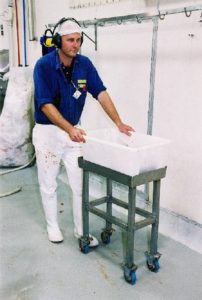Changing the design or layout of work areas
A well-designed work area will assist in eliminating or reducing the risk factors associated with a hazardous manual task, such as the degree of reaching, twisting or bending.
Changing the nature, size, weight or number of items handled
Examples of control measures that may be considered when handling loads include:
- purchasing products in smaller loads for manual handling or larger loads to be shifted mechanically
- reducing the size or capacity of containers
- using grip devices adapted to the particular object to be carried.
Using mechanical aids
Mechanical equipment may eliminate or reduce the need for workers to lift, carry or support items, animals or people. A wide range of mechanical aids is available for example:
- conveyors such as roller conveyors, elevating conveyors, belt conveyors, screw conveyors, chutes, monorails or trolley conveyors
- cranes such as overhead travelling cranes, gantry cranes or jib cranes, stacker cranes, industrial manipulators and articulating arms
- lifting hoists
- loading dock levellers
- turntables
- springs or gas struts, mechanical devices such as hand winches, hydraulic pumps, and battery powered motors
- forklifts, platforms trucks, tractor-trailer trains, tugs and pallet trucks
- lift tables, mechanical and hand stackers, lift trolleys, two-wheel elevating hand trucks, and vacuum or magnet assisted lifters.

Tub on wheels reduces the risk of manual handling injury
Courtesy of Meat and Livestock Australia
Handling animals
When animals are being handled consider the following:
- using mechanical devices or other restraining aids for lifting, transporting or restraining animals
- moving the animal to a place that constrains or minimises the movement of the animal before commencing the task
- where handling is required, assessing the needs of the task including the specific type of mechanical aids and personnel, and planning it in a manner that avoids double-handling
- where the use of a mechanical aid or assistive device requires two or more people, providing adequate resources so that workers under time pressure don’t try to complete the task on their own.
Changing the system of work
The workload and pace should accommodate the physical demands of the manual task. Workers should not have to work at a rate that is at the limit of their ability. Task design should take account of the range of human dimensions and capabilities such as height, reach and weight.
Changing the work environment
This includes controls to reduce risks associated with areas including:
- extremes of temperature
- floors and surfaces
- lighting
Using administrative control measures
Administrative control measures do not address the source of the risk – they only attempt to reduce risk by reducing exposure to those risk factors. Administrative controls include:
- job rotation
- rest breaks
- team handling
- information, instruction and training
- work instructions, SOPs.
Step four: Review control measures
Control measures that have been put in place need to be reviewed to check that they have actually achieved what they were designed to do and eliminated or reduced the risks to the lowest possible levels. Management also needs to review the control measures to ensure the controls have not introduced different risks.
Workers or operators of plant and equipment are well positioned to help management review control measures as it is the operators who are most familiar with the work being done and can provide feedback needed.
